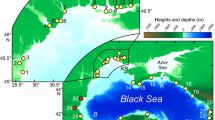Abstract
Semi-diurnal tides in the Yellow Sea are calculated by integrating the shallow water wave equations with frictional and inertial terms.
It is found that the results depend on the bottom friction. In the frictionless case the tidal range is unstably amplified because of the occurrence of resonance of the semi-diurnal tidal component in Inchon Bay. When the bottom friction is in the form of the square of velocity, the results agree fairly well with the observations.
The following results are obtained. First, the tidal range is larger at the coast of the Korean Peninsula than at the China Coast. Second, resonance of the semi-diurnal tide occurs in Inchon Bay. Third, bottom friction is very important in the shallow ocean,i.e., when the bottom friction become large, the phase lag is retarded and the tidal range decreases.
The amplitude and the phase lag calculated in this study agree well with the observations in the case ofΤ b =γb 2 V¦V¦,γ b 2=0.0026, especially in the coast of the Korean Peninsula.
Similar content being viewed by others
References
An, H.S. andS.W. Lee (1976): A numerical experiment on tidal current in Asan Bay. J. Oceanogr. Soc. Korea,11, 18–24.
Dishon, M. (1964): Determination of average ocean depths from bathymetric data. Inter. Hydrogr. Review,XLI, 77–90.
Hendershott, M.C. (1972): The effects of solid earth deformation on global ocean tides. Geophys. J. R. Astr. Soc.,29, 389–402.
Hendershott, M.C. andA. Speranza (1971): Cooscillating tides in long, narrow bays; the Taylor problem revisited. Deep-Sea Res.,18, 959–980.
Mathew, J.B. andJ. C. H. Mungall (1972): A numerical tidal model and its application to Cook Inlet, Alaska. J. Mar. Res.,30, 27–38.
Ogura S. (1941): Tides (in Japanese). Iwanami Co., Tokyo, 252 pp.
Pekeris, C. L. andY. Accad (1969): Solution of Laplace's equations for the M2 tide in the world oceans. Phil. Trans. Roy. Soc. London,265, 413–436.
Pnueli, A. andC. L. Pekeris (1968): Free tidal oscillations in rotating flat basins of the form of rectangles and of sectors of circles. Phil. Trans. Roy. Soc. London,263, 149–171.
Proudman, J. (1952): Dynamical Oceanography. Methuen & Co.Ltd., 36 Essex Street, Strand WC 2, 409 pp.
Ueno T. (1964): Theoretical studies on tidal waves travelling over the rotating globe (1). Oceanogr. Mag.,15, 99–111.
Ueno, T. (1964): Theoretical studies on tidal waves travelling over the rotating globe (2). Oceanogr. Mag.,16, 47–124.
Unoki, S. andI. Isozaki (1965): Mean sea level in bays, with special reference to the mean slope of the sea surface due to the standing oscillation of tide. Oceanogr. Mag.,17, 11–35.
Webb, D. J. (1976): A model of continental-shelf resonances. Deep-Sea Res.,23, 1–15.
Zahel, W. (1970): Die reproduktion gezeitenbedingter bewegungsvorgaenge im Weltozean mittels des Hydrodynamisch Numerischen verfahrens. Mitteilungen des Institute für Meereskunde der UniversitÄt-Hamburg,17, 50 pp.
Author information
Authors and Affiliations
Rights and permissions
About this article
Cite this article
An, H.S. A numerical experiment of the M2 tide in the Yellow sea. Journal of the Oceanographical Society of Japan 33, 103–110 (1977). https://doi.org/10.1007/BF02110016
Received:
Revised:
Accepted:
Issue Date:
DOI: https://doi.org/10.1007/BF02110016



